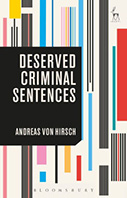Deserved Criminal Sentences: An Overview

Author: Andreas von Hirsch
Publisher: Oxford, UK; Portland, OR: Hart Publishing. 192p.
Reviewer: Julian V. Roberts | July 2017
Last year (2016) marked the 40th anniversary of the seminal volume on proportionate sentencing ‘Doing Justice’ (1976, New York: Hill and Wang). In that volume Andrew von Hirsch articulated the essential elements of desert theory for the first time. Desert theory has proven to be very influential throughout the common law world, and the 1976 work shaped the development of sentencing guidelines across the US (particularly in Minnesota), and influenced sentencing statutes in many other jurisdictions, including Canada, and England and Wales. In addition to its influence upon sentencing practice and in particular the US guidelines, ‘Doing Justice’ also spawned a rich scholarly literature on desert theory. Over the years, von Hirsch himself has contributed significantly to that literature (e.g., 1985).In March 2017 Hart Publications of Oxford and Portland Oregon published the latest volume by Professor von Hirsch: Deserved Criminal Sentences. This latest work is a short primer which provides an accessible and systematic restatement of the desert model for criminal sentencing by its leading academic exponent. The desert-based sentencing model emphasizes the degree of seriousness of the offender’s crime in deciding the severity of his punishment, and has become increasingly influential in recent penal practice and scholarly debate (see also Proportionate Sentencing (von Hirsch and Ashworth, 2005, Oxford: Oxford University Press).
This primer in desert theory explains why sentences should be based principally on crime-seriousness, and addresses, among other topics, how a desert-based penalty scheme can be constructed; how to gauge punishments’ seriousness and penalties’ severity; what weight should be given to an offender’s previous convictions; how non-custodial sentences should be scaled; and what leeway there might be for taking other factors into account, such as an offender’s need for treatment. It concludes with a chapter describing the application of desert theory to the sentencing of juvenile offenders. Von Hirsch offers the reader a succinct account of the principal issues addressed by desert theory, beginning with a discussion of the origins of the desert model of sentencing. Readers will find the volume’s appendix, which presents a brief chronology of the desert model, a useful adjunct to the first chapter. This historical account is followed by an exposition of the concept of proportional sentencing.
The volume will be of interest to all those working in penal theory and practice, criminal sentencing and the criminal law more generally. It will be particularly useful for students or readers seeking a concise and up to date summary of the issues and literature relating to desert-based sentencing. Von Hirsch provides an eminently readable account of some of the most complex (and unresolved) challenges to desert theory, such as the role of previous convictions at sentencing. Desert theory has evolved significantly over the past 40 years, and the number of theorists working on proportionality has also grown. The present volume provides a very useful overview of the field from the leading retributive sentencing theorist. As such it is likely to bring new scholars to the field and stimulate even more interest in desert-based sentencing.
References
Von Hirsch, A. (1976) Doing Justice. The Choice of Punishments. New York: Hill and Wang (Reprinted in 1986, Boston, Northeastern University Press.)
Von Hirsch, A. (1985) Past or Future Crimes: Deservedness and Dangerousness in the Sentencing of Criminals. New Brunswick, New Jersey: Rutgers University Press.
Julian V. Roberts, Faculty of Law, University of Oxford.


